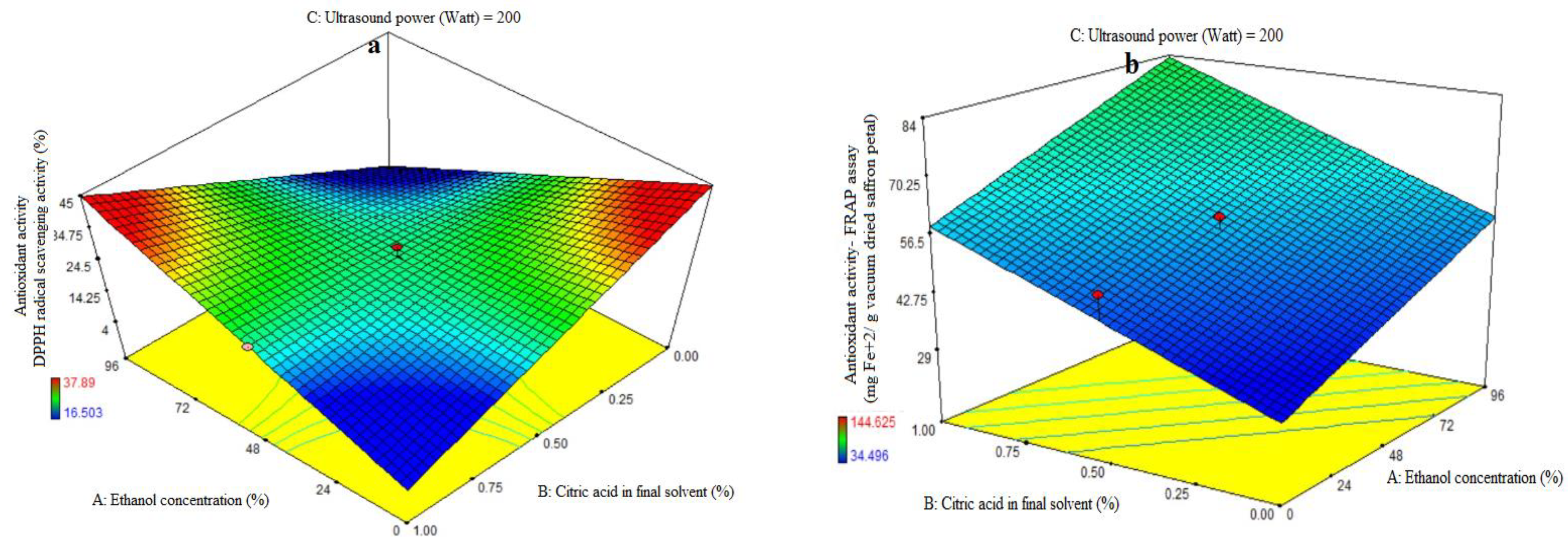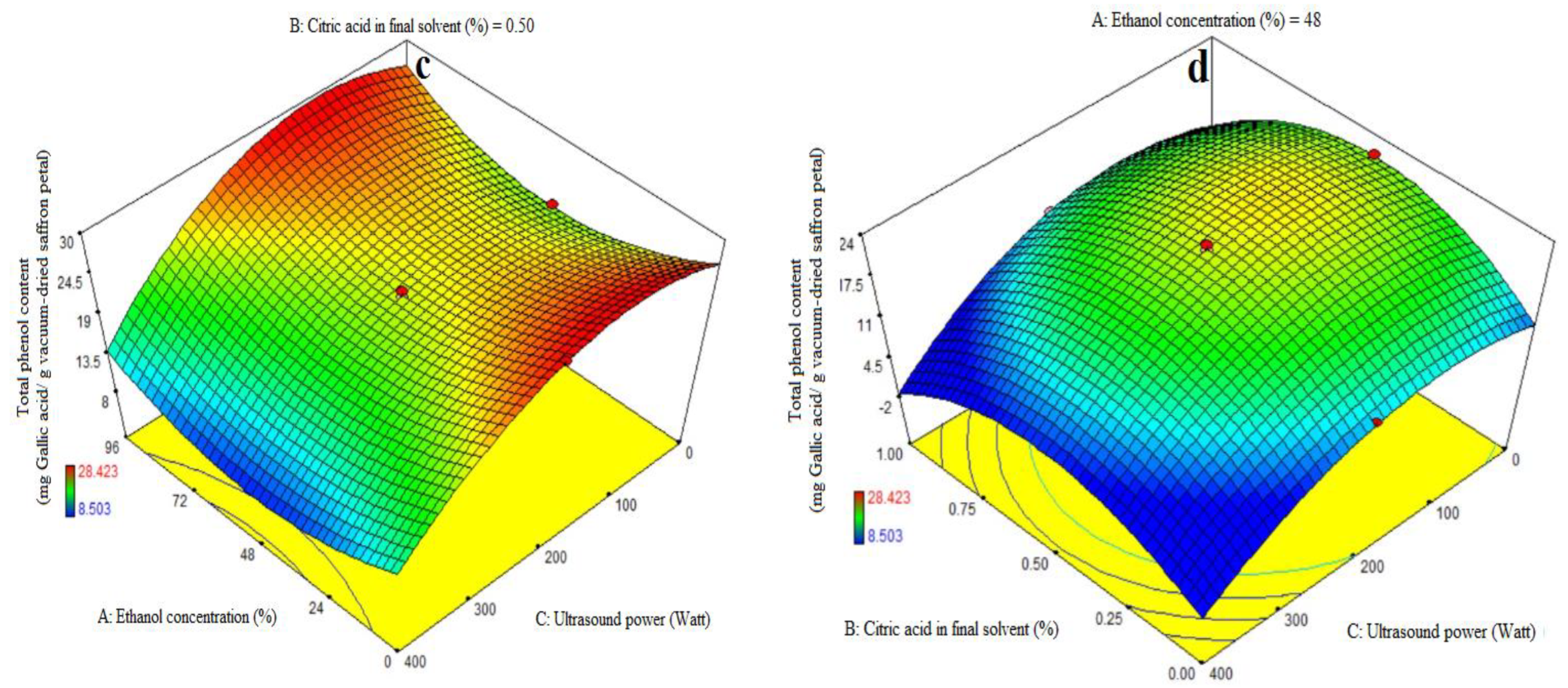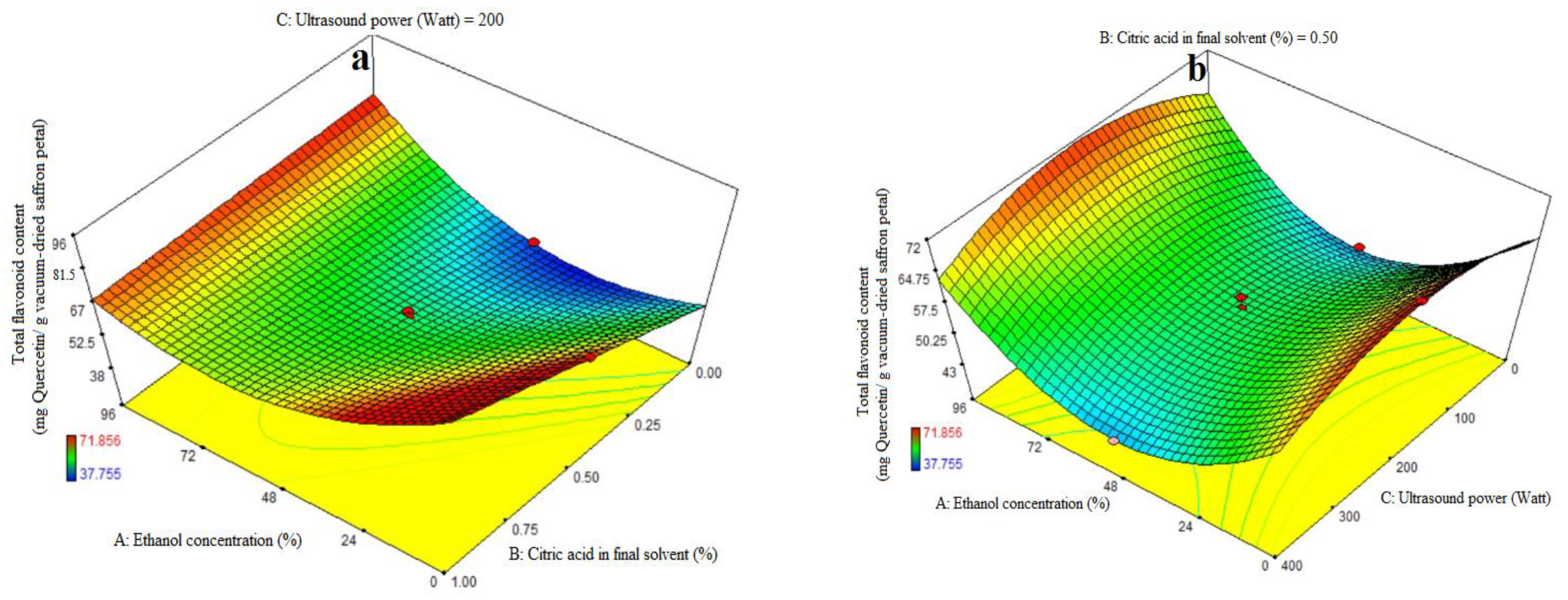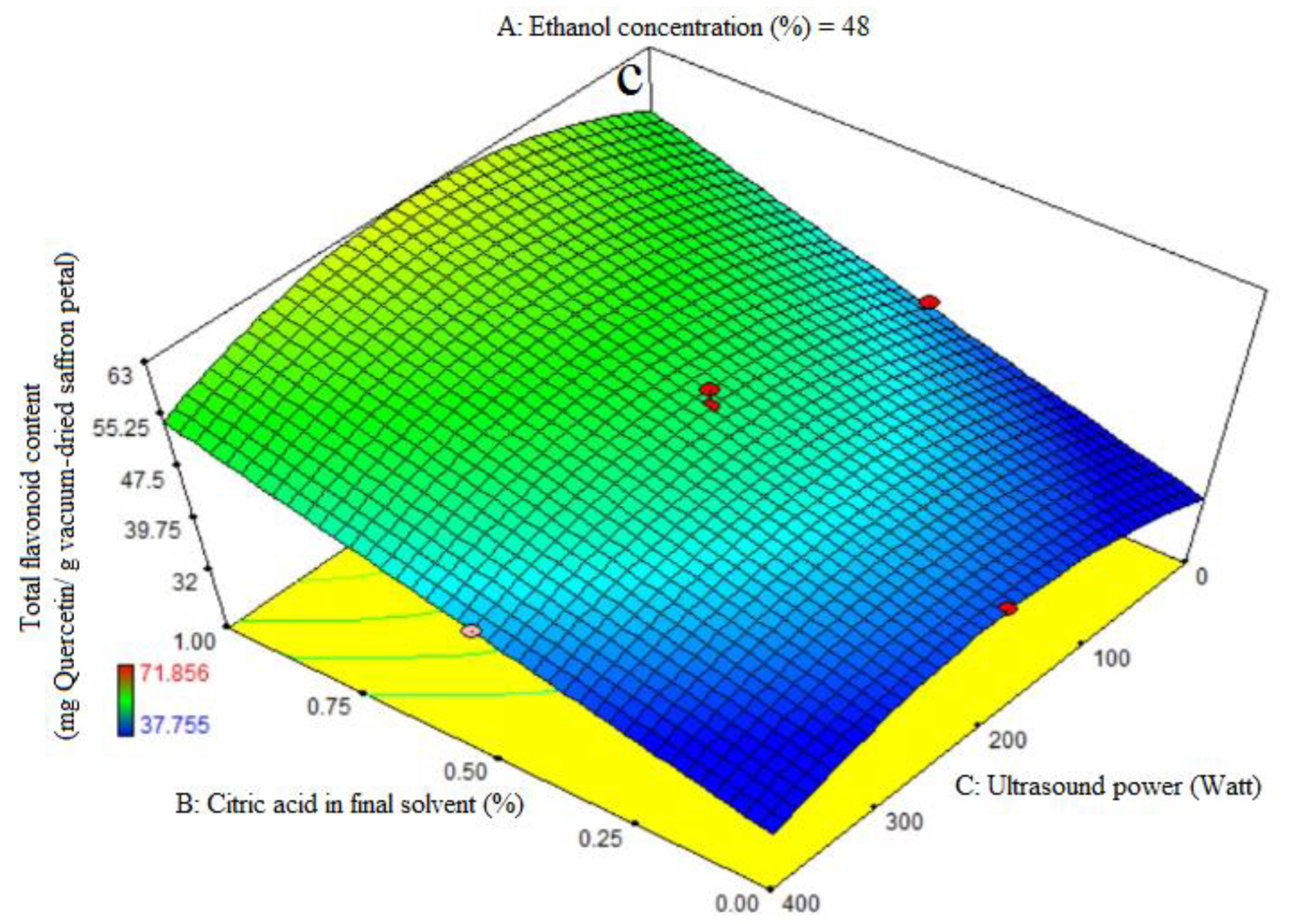Optimization of Bioactive Compound Extraction from Saffron Petals Using Ultrasound-Assisted Acidified Ethanol Solvent: Adding Value to Food Waste
Abstract
:1. Introduction
2. Materials and Method
2.1. Raw Materials and Sample Extract Preparation
2.2. Antioxidant Activity Assessment
2.2.1. DPPH Radical Scavenging Activity
2.2.2. Ferric Reducing Antioxidant Power (FRAP) Assay
2.3. Total Monomeric Anthocyanin Pigment Determination
2.4. Total Phenolic Content (TPC) Determination
2.5. Total Flavonoid Content Determination
2.6. Experimental Design and Statistical Analysis
3. Results and Discussion
3.1. Fitting the Response Surface Models for Antioxidant Activity Based on DPPH Radical Scavenging Activity
3.2. Fitting the Response Surface Models for Antioxidant Activity Based on FRAP Assay
3.3. Fitting the Response Surface Models for Total Anthocyanin Content
3.4. Fitting the Response Surface Models for Total Phenol Content (TPC)
3.5. Fitting the Response Surface Models for Total Flavonoid Content (TFC)
3.6. Optimization of the Solvent Formulation and Survey of Actual and Predicted Data
4. Conclusions
Author Contributions
Funding
Data Availability Statement
Acknowledgments
Conflicts of Interest
Abbreviations
References
- Rahaiee, S.; Moini, S.; Hashemi, M.; Shojaosadati, S.A. Evaluation of antioxidant activities of bioactive compounds and various extracts obtained from saffron (Crocus sativus L.): A review. J. Food Sci. Technol. 2015, 52, 1881–1888. [Google Scholar] [CrossRef]
- Ahmadian-Kouchaksaraie, Z.; Niazmand, R. Supercritical carbon dioxide extraction of antioxidants from Crocus sativus petals of saffron industry residues: Optimization using response surface methodology. J. Supercrit. Fluids 2017, 121, 19–31. [Google Scholar] [CrossRef]
- Wu, Y.; Gong, Y.; Sun, J.; Zhang, Y.; Luo, Z.; Nishanbaev, S.Z.; Usmanov, D.; Song, X.; Zou, L.; Benito, M.J. Bioactive components and biological activities of Crocus sativus L. byproducts: A Comprehensive Review. J. Agric. Food Chem. 2023, 71, 19189–19206. [Google Scholar] [CrossRef] [PubMed]
- Hashemi Gahruie, H.; Parastouei, K.; Mokhtarian, M.; Rostami, H.; Niakousari, M.; Mohsenpour, Z. Application of innovative processing methods for the extraction of bioactive compounds from saffron (Crocus sativus) petals. J. Appl. Res. Med. Aromat. Plants 2020, 19, 100264. [Google Scholar] [CrossRef]
- Ferarsa, S.; Zhang, W.; Moulai-Mostefa, N.; Ding, L.; Jaffrin, M.Y.; Grimi, N. Recovery of anthocyanins and other phenolic compounds from purple eggplant peels and pulps using ultrasonic-assisted extraction. Food Bioprod. Process. 2018, 109, 19–28. [Google Scholar] [CrossRef]
- Barba, F.J.; Zhu, Z.; Koubaa, M.; SantAna, A.S.; Orlien, V. Green alternative methods for the extraction of antioxidant bioactive compounds from winery wastes and by-products: A review. Trends Food Sci. Technol. 2016, 49, 96–109. [Google Scholar] [CrossRef]
- Xie, Q.; Tang, Y.; Wu, X.; Luo, Q.; Zhang, W.; Liu, H.; Fung, Y.; Yue, X.; Ju, Y. Combined ultrasound and low temperature pretreatment improve the content of anthocyanins, phenols and volatile substance of Merlot red wine. Ultrason. Sonochem. 2023, 100, 106636. [Google Scholar] [CrossRef] [PubMed]
- Saleh, I.A.; Vinatoru, M.; Mason, T.J.; Abdel-Azim, N.S.; Aboutabl, E.A.; Hammouda, F.M. A possible general mechanism for ultrasound-assisted extraction (UAE) suggested from the results of UAE of chlorogenic acid from Cynara scolymus L. (artichoke) leaves. Ultrason. Sonochem. 2016, 31, 330–336. [Google Scholar] [CrossRef] [PubMed]
- Manouchehri, R.; Saharkhiz, M.J.; Karami, A.; Niakousari, M. Extraction of essential oils from damask rose using green and conventional techniques: Microwave and ohmic assisted hydrodistillation versus hydrodistillation. Sustain. Chem. Pharm. 2018, 8, 76–81. [Google Scholar] [CrossRef]
- Maric, M.; Grassino, A.N.; Zhu, Z.; Barba, F.J.; Brncic, M.; Brncic, S.R. An overview of the traditional and innovative approaches for pectin extraction from plant food wastes and by-products: Ultrasound-, microwaves-, and enzyme-assisted extraction. Trends Food Sci. Technol. 2018, 76, 28–37. [Google Scholar] [CrossRef]
- Chemat, F.; Rombaut, N.; Meullemiestre, A.; Turk, M.; Perino, S.; Fabiano-Tixier, A.S.; Abert-Vian, M. Review of green food processing techniques. Preservation, transformation, and extraction. Innov. Food Sci. Emerg. Technol. 2017, 41, 357–377. [Google Scholar] [CrossRef]
- Ozgur, M.U.; Çimen, E. Ultrasound-assisted extraction of anthocyanins from red rose petals and new spectrophotometric methods for the determination of total monomeric anthocyanins. J. AOAC Int. 2018, 101, 967–980. [Google Scholar] [CrossRef]
- Shahabi Mohammadabadi, S.; Goli, M.; Naji Tabasi, S. Optimization of bioactive compound extraction from eggplant peel by response surface methodology: Ultrasound-assisted solvent qualitative and quantitative effect. Foods 2022, 11, 3263. [Google Scholar] [CrossRef]
- Munteanu, I.G.; Apetrei, C. Analytical methods used in determining antioxidant activity: A review. Int. J. Mol. Sci. 2021, 22, 3380. [Google Scholar] [CrossRef]
- Yancheshmeh, B.S.; Panahi, Y.; Allahdad, Z.; Abdolshahi, A.; Zamani, Z. Optimization of ultrasound-assisted extraction of bioactive compounds from Achillea kellalensis using response surface methodology. J. Appl. Res. Med. Aromat. Plants 2022, 28, 100355. [Google Scholar] [CrossRef]
- Kobus, Z.; Pecyna, A.; Buczaj, A.; Krzywicka, M.; Przywara, A.; Nadulski, R. Optimization of the ultrasound-assisted extraction of bioactive compounds from Cannabis sativa L. leaves and inflorescences using response surface methodology. Appl. Sci. 2022, 12, 6747. [Google Scholar] [CrossRef]
- AOAC. Estimation of total phenolic content using the Folin-C assay. J. AOAC Int. 2015, 98, 1109–1110. [Google Scholar] [CrossRef]
- Matic, P.; Sabljic, M.; Jakobek, L. Validation of spectrophotometric methods for the determination of total polyphenol and total flavonoid content. J. AOAC Int. 2017, 100, 1795–1803. [Google Scholar] [CrossRef]
- Maestre-Hernandez, A.B.; Vicente-Lopez, J.J.; Pérez-Llamas, F.; Candela-Castillo, M.E.; García-Conesa, M.T.; Frutos, M.J.; Cano, A.; Hernandez-Ruiz, J.; Arnao, M.B. Antioxidant activity, total phenolic and flavonoid contents in floral saffron bio-residues. Processes 2023, 11, 1400. [Google Scholar] [CrossRef]
- Jalalizand, F.; Goli, M. Optimization of microencapsulation of selenium with gum Arabian/Persian mixtures by solvent evaporation method using response surface methodology (RSM): Soybean oil fortification and oxidation indices. J. Food Meas. Charact. 2021, 15, 495–507. [Google Scholar] [CrossRef]
- Zaghian, N.; Goli, M. Optimization of the production conditions of primary (W1/O) and double (W1/O/W2) nanoemulsions containing vitamin B12 in skim milk using ultrasound wave by response surface methodology. J. Food Meas. Charact. 2020, 14, 3216–3226. [Google Scholar] [CrossRef]
- Sazesh, B.; Goli, M. Quinoa as a wheat substitute to improve the textural properties and minimize the carcinogenic acrylamide content of the biscuit. J. Food Process. Preserv. 2020, 44, e14563. [Google Scholar] [CrossRef]
- Maghamian, N.; Goli, M.; Najarian, A. Ultrasound-assisted preparation of double nano-emulsions loaded with glycyrrhizic acid in the internal aqueous phase and skim milk as the external aqueous phase. LWT—Food Sci. Technol. 2021, 141, 108–109. [Google Scholar] [CrossRef]
- Agustin, A.R.; Falka, S.; Ju, Y. Influence of extracting solvents on its antioxidant properties of bawang Dayak (Eleutherine palmifolia L. Merr). Int. J. Chem. Petrochem. Technol. 2016, 2, 1–10. [Google Scholar]
- Moure, A.; Cruz, J.M.; Franco, D.; Dominguez, J.M.; Sineiro, J.; Dominguez, H.; Nunez, M.J.; Parajo, J.C. Natural antioxidants from residual sources. Food Chem. 2001, 72, 145–171. [Google Scholar] [CrossRef]
- Boulekbache-Makhlouf, L.; Medouni, L.; Medouni-Adrar, S.; Arkoub, L.; Madani, K. Effect of solvents extraction on phenolic content and antioxidant activity of the byproduct of eggplant. Ind. Crops Prod. 2013, 49, 668–674. [Google Scholar] [CrossRef]
- Nawaz, H.; Shad, M.A.; Rehman, N.; Andaleeb, H.; Ullah, N. Effect of solvent polarity on extraction yield and antioxidant properties of phytochemicals from bean (Phaseolus vulgaris) seeds. Braz. J. Pharm. Sci. 2020, 56, e17129. [Google Scholar] [CrossRef]
- Halee, A.; Supavititpatana, P.; Ruttarattanamongkol, K.; Jittrepotch, N.; Rojsuntornkitti, K.; Kongbangkerd, T. Effects of solvent types and citric acid concentrations on the extraction of antioxidants from the black rice bran of Oryza sativa L. CV. Hom Nin. J. Microbiol. Biotechnol. Food Sci. 2018, 8, 765. [Google Scholar] [CrossRef]
- Alothman, M.; Bhat, R.; Karim, A. Antioxidant capacity and phenolic content of selected tropical fruits from Malaysia, extracted with different solvents. Food Chem. 2009, 115, 785–788. [Google Scholar] [CrossRef]
- Todaro, A.; Cimino, F.; Rapisarda, P.; Catalano, A.E.; Barbagallo, R.N.; Spagna, G. Recovery of anthocyanins from eggplant peel. Food Chem. 2009, 114, 434–439. [Google Scholar] [CrossRef]
- Stelluti, S.; Caser, M.; Demasi, S.; Scariot, V. Sustainable processing of floral bio-residues of saffron (Crocus sativus L.) for valuable biorefinery products. Plants 2021, 10, 523. [Google Scholar] [CrossRef]
- Hosseini, S.; Gharachorloo, M.; Ghiassi-Tarzi, B.; Ghavami, M. Evaluation of the organic acids ability for extraction of anthocyanins and phenolic compounds from different sources and their degradation kinetics during cold storage. Pol. J. Food Nutr. Sci. 2016, 66, 261–270. [Google Scholar] [CrossRef]
- Das, A.B.; Goud, V.; Das, C. Extraction of phenolic compounds and anthocyanin from black and purple rice bran (Oryza sativa L.) using ultrasound: A comparative analysis and phytochemical profiling. Ind. Crops Prod. 2017, 95, 332–341. [Google Scholar] [CrossRef]
- Li, Y.; Han, L.; Ma, R.; Xu, X.; Zhao, C.; Wang, Z.; Chen, F.; Hu, X. Effect of energy density and citric acid concentration on anthocyanins yield and solution temperature of grape peel in microwave-assisted extraction process. J. Food Eng. 2012, 109, 274–280. [Google Scholar] [CrossRef]
- Andrade, T.A.; Hamerski, F.; Fetzer, D.E.L.; Roda-Serrat, M.C.; Corazza, M.L.; Norddahl, B.; Errico, M. Ultrasound-assisted pressurized liquid extraction of anthocyanins from Aronia melanocarpa pomace. Sep. Purif. Technol. 2021, 276, 119290. [Google Scholar] [CrossRef]
- Oladunjoye, A.O.; Olawuyi, I.K.; Afolabi, T.A. Synergistic effect of ultrasound and citric acid treatment on functional, structural and storage properties of hog plum (Spondias mombin L.) bagasse. Food Sci. Technol. Int. 2023, 10820132231176579. [Google Scholar] [CrossRef]
- Buvaneshwaran, M.; Radhakrishnan, M.; Natarajan, V. Influence of ultrasound-assisted extraction techniques on the valorization of agro-based industrial organic waste—A review. J. Food Process Eng. 2022, 46, e14012. [Google Scholar] [CrossRef]
- Naczk, M.; Shahidi, F. Extraction and analysis of phenolics in food. J. Chromatogr. A 2004, 1054, 95–111. [Google Scholar] [CrossRef]
- Naczk, M.; Shahidi, F. Phenolics in cereals, fruits and vegetables: Occurrence, extraction and analysis. J. Pharm. Biomed. Anal. 2006, 41, 1523–1542. [Google Scholar] [CrossRef]
- Chirinos, R.; Rogez, H.; Camposa, D.; Pedreschi, R.; Larondelle, Y. Optimization of extraction conditions of antioxidant phenolic compounds from mashua (Tropaeolum tuberosum Ruız & Pavon) tubers. Sep. Purif. Technol. 2007, 55, 217–225. [Google Scholar]
- Fatiha, B.; Khodir, M.; Farid, D.; Tiziri, R.; Karima, B.; Sonia, O.; Mohamed, C. Optimisation of solvent extraction of antioxidants (phenolic compounds) from Algerian mint (Mentha spicata L.). Pharmacogn. Commun. 2012, 4, 72–86. [Google Scholar]
- Ukrainczyk, L.; McBride, M.B. Oxidation of phenolics in acidic aqueous suspensions of manganese oxides. Clays Clay Miner. 1992, 40, 157–166. [Google Scholar] [CrossRef]
- Jirum, J.; Srihanam, P. Oxidants and antioxidants: Sources and mechanism. Acad. J. Kalasin Rajabhat Univ. 2011, 1, 59–70. [Google Scholar]
- Lachguer, K.; El Merzougui, S.; Boudadi, I.; Laktib, A.; Ben El Caid, M.; Ramdan, B.; Boubaker, H.; Serghini, M.A. Major phytochemical compounds, in vitro antioxidant, antibacterial, and antifungal activities of six aqueous and organic extracts of Crocus sativus L. flower waste. Waste Biomass Valorization 2023, 14, 1571–1587. [Google Scholar] [CrossRef]
- Gadioli Tarone, A.; Keven Silva, E.; Dias de Freitas Queiroz Barros, H.; Bau Betim Cazarin, C.; Roberto Marostica, M., Jr. High-intensity ultrasound-assisted recovery of anthocyanins from jabuticaba by-products using green solvents: Effects of ultrasound intensity and solvent composition on the extraction of phenolic compounds. Food Res. Int. 2021, 140, 110048. [Google Scholar] [CrossRef]






| Independent Variables | Code | Symbol | |||||||
|---|---|---|---|---|---|---|---|---|---|
| −α | −1 | 0 | 1 | +α | |||||
| Ethanol concentration (%) | A | 0 | 24 | 48 | 72 | 96 | |||
| Citric acid concentration concentration in final solvent (%) | B | 0 | 0.25 | 0.5 | 0.75 | 1 | |||
| Ultrasound power (watt) | C | 0 | 100 | 200 | 300 | 400 | |||
| Run | Ethanol Concentration (%) | Citric Acid Concentration in Final Solvent (%) | Ultrasound Power (Watt) | Antioxidant Activity (DPPH-Assay) * | Antioxidant Activity (FRAP Assay) ** | Total Anthocyanin Content *** | Total Phenol Content **** | Total Flavonoid Content ***** | |
| 1 | 72 | 0.75 | 300 | 31.152 | 85.57 | 5.444 | 15.556 | 55.77 | |
| 2 | 48 | 0.5 | 0 | 34.388 | 39.965 | 4.447 | 21.268 | 44.322 | |
| 3 | 24 | 0.25 | 100 | 25.149 | 34.496 | 4.872 | 20.696 | 48.131 | |
| 4 | 48 | 0.5 | 200 | 27.539 | 106.345 | 4.038 | 15.6 | 49.281 | |
| 5 | 72 | 0.75 | 100 | 27.734 | 144.625 | 4.278 | 22.084 | 58.203 | |
| 6 | 48 | 0.5 | 400 | 24.208 | 67.202 | 4.708 | 21.901 | 43.514 | |
| 7 | 24 | 0.75 | 100 | 22.155 | 54.708 | 4.528 | 24.252 | 61.309 | |
| 8 | 24 | 0.25 | 300 | 18.457 | 71.961 | 3.133 | 11.779 | 42.18 | |
| 9 | 48 | 0.5 | 200 | 23.695 | 52.812 | 4.609 | 22.127 | 54.392 | |
| 10 | 48 | 0 | 200 | 37.89 | 92.541 | 3.276 | 13.082 | 41.152 | |
| 11 | 48 | 0.5 | 200 | 23.096 | 57.766 | 3.327 | 22.876 | 51.787 | |
| 12 | 72 | 0.25 | 300 | 27.734 | 77.523 | 4.812 | 18.23 | 51.867 | |
| 13 | 72 | 0.25 | 100 | 20.188 | 56.691 | 5.122 | 23.148 | 64.063 | |
| 14 | 96 | 0.5 | 200 | 16.503 | 62.702 | 1.838 | 8.503 | 37.755 | |
| 15 | 48 | 1 | 200 | 24.218 | 120.996 | 4.607 | 12.348 | 39.521 | |
| 16 | 24 | 0.75 | 300 | 18.477 | 55.828 | 5.063 | 19.506 | 64.936 | |
| 17 | 0 | 0.5 | 200 | 24.208 | 50.377 | 4.554 | 28.423 | 71.856 | |
| Antioxidant Activity in Terms of DPPH Radical Scavenging Activity (%) | |||||||
|---|---|---|---|---|---|---|---|
| Source | Coefficient of Final Equation in Terms of Coded Factors | Sum of Squares | df | Mean Square | F-Value | Prob > F | |
| Model | 44.71 | 103.57 | 3 | 34.52 | 9.58 | 0.0163 | significant |
| A-Ethanol concentration (%) | −0.406 | 0.23 | 1 | 0.23 | 0.064 | 0.8106 | |
| B-Citric acid concentration in final solvent (%) | −41.723 | 0.43 | 1 | 0.43 | 0.12 | 0.7438 | |
| AB | 0.841 | 46.71 | 1 | 46.71 | 12.96 | 0.0155 | |
| Residual | - | 18.03 | 5 | 3.61 | - | - | |
| Lack of Fit | - | 6.4 | 3 | 2.13 | 0.37 | 0.7884 | not significant |
| Pure Error | - | 11.63 | 2 | 5.81 | - | - | |
| Cor Total | - | 121.59 | 8 | - | - | - | |
| R2: 0.85, Adj-R2: 0.77, Adeq precision: 8.53, C.V.: 7.76% | |||||||
| Antioxidant Activity in Terms of FRAP Assay (mg Fe+2/g Vacuum-Dried Saffron Petal) | |||||||
| Source | Coefficient of Final Equation in Terms of Coded Factors | Sum of Squares | df | Mean Square | F-Value | Prob > F | |
| Model | 17.769 | 1474.94 | 3 | 491.65 | 10.24 | 0.0059 | significant |
| A-Ethanol concentration (%) | 0.256 | 471.48 | 1 | 471.48 | 9.82 | 0.0165 | |
| B-Citric acid concentration in final solvent (%) | 28.99 | 213.79 | 1 | 213.79 | 4.45 | 0.0728 | |
| C-Ultrasound power (watt) | 0.061 | 395.92 | 1 | 395.92 | 8.25 | 0.0239 | |
| Residual | - | 336.06 | 7 | 48.01 | - | - | |
| Lack of Fit | - | 323.78 | 6 | 53.96 | 4.4 | 0.3497 | not significant |
| Pure Error | - | 12.27 | 1 | 12.27 | - | - | |
| Cor Total | - | 1811 | 10 | - | - | - | |
| R2: 0.81, Adj-R2: 0.73, Adeq precision: 9.30, C.V.: 12.33% | |||||||
| Total Anthocyanin Content (mg Cyanidin-3-Glucoside/g Vacuum-Dried Saffron Petal) | |||||||
|---|---|---|---|---|---|---|---|
| Source | Coefficient of Final Equation in Terms of Coded Factors | Sum of Squares | df | Mean Square | F-Value | Prob > F | |
| Model | 6.73 | 4.5 | 3 | 1.5 | 15.55 | 0.0007 | significant |
| B-Citric acid concentration in final solvent (%) | −4.022 | 1.88 | 1 | 1.88 | 19.44 | 0.0017 | |
| C-Ultrasound power (watt) | −0.016 | 0.36 | 1 | 0.36 | 3.72 | 0.0859 | |
| BC | 0.027 | 3.11 | 1 | 3.11 | 32.19 | 0.0003 | |
| Residual | - | 0.87 | 9 | 0.097 | - | - | |
| Lack of Fit | - | 0.71 | 8 | 0.088 | 0.54 | 0.789 | not significant |
| Pure Error | - | 0.16 | 1 | 0.16 | - | - | |
| Cor Total | - | 5.37 | 12 | - | - | - | |
| R2: 0.84, Adj-R2: 0.78, Adeq precision: 12.09, C.V.: 6.97% | |||||||
| Total Phenol Content (mg Gallic Acid/g Vacuum-Dried Saffron Petal) | |||||||
| Source | Coefficient of Final Equation in Terms of Coded Factors | Sum of Squares | df | Mean Square | F-Value | Prob > F | |
| Model | 8.71 | 302.31 | 7 | 43.19 | 22.63 | 0.0007 | significant |
| A-Ethanol concentration (%) | −0.096 | 0.67 | 1 | 0.67 | 0.35 | 0.5749 | |
| B-Citric acid concentration in final solvent (%) | 55.69 | 2.31 | 1 | 2.31 | 1.21 | 0.3136 | |
| C-Ultrasound power (watt) | 0.046 | 89.9 | 1 | 89.9 | 47.1 | 0.0005 | |
| AB | −0.313 | 28.2 | 1 | 28.2 | 14.78 | 0.0085 | |
| A2 | 0.0028 | 21.89 | 1 | 21.89 | 11.47 | 0.0147 | |
| B2 | −39.15 | 95.78 | 1 | 95.78 | 50.18 | 0.0004 | |
| C2 | −0.0002 | 33.14 | 1 | 33.14 | 17.36 | 0.0059 | |
| Residual | - | 11.45 | 6 | 1.91 | - | - | |
| Lack of Fit | - | 11.17 | 5 | 2.23 | 7.97 | 0.2625 | not significant |
| Pure Error | - | 0.28 | 1 | 0.28 | - | - | |
| Cor Total | - | 313.76 | 13 | - | - | - | |
| R2: 0.96, Adj-R2: 0.92, Adeq precision: 15.63, C.V.: 7.02% | |||||||
| Total Flavonoid Content (mg Quercetin/g Vacuum-Dried Saffron Petal) | |||||||
| Source | Coefficient of Final Equation in Terms of Coded Factors | Sum of Squares | df | Mean Square | F-Value | Prob > F | |
| Model | 39.863 | 1026.86 | 6 | 171.14 | 30.62 | 0.0001 | significant |
| A-Ethanol concentration (%) | −0.548 | 0.28 | 1 | 0.28 | 0.049 | 0.8304 | |
| B-Citric acid concentration in final solvent (%) | 49.048 | 289.07 | 1 | 289.07 | 51.71 | 0.0002 | |
| C-Ultrasound power (watt) | 0.075 | 3.39 | 1 | 3.39 | 0.61 | 0.4619 | |
| AB | −0.565 | 73.46 | 1 | 73.46 | 13.14 | 0.0085 | |
| A2 | 0.0088 | 218.66 | 1 | 218.66 | 39.12 | 0.0004 | |
| C2 | −0.0002 | 81.95 | 1 | 81.95 | 14.66 | 0.0065 | |
| Residual | - | 39.13 | 7 | 5.59 | - | - | |
| Lack of Fit | - | 26.07 | 5 | 5.21 | 0.8 | 0.6378 | not significant |
| Pure Error | - | 13.06 | 2 | 6.53 | - | - | |
| Cor Total | - | 1065.99 | 13 | - | - | - | |
| R2: 0.96, Adj-R2: 0.93, Adeq precision: 18.36, C.V.: 4.48% | |||||||
| Name | Upper | Lower | Upper | |||
|---|---|---|---|---|---|---|
| Goal | Limit | Limit | Weight | Weight | Importance | |
| A-Ethanol concentration (%) | is in range | 0 | 96 | 1 | 1 | 3 |
| B-Citric acid concentration in final solvent (%) | is in range | 0 | 1 | 1 | 1 | 3 |
| C-Ultrasound power (watt) | is in range | 0 | 400 | 1 | 1 | 3 |
| Antioxidant activity-DPPH radical scavenging activity (%) | maximize | 18.477 | 31.152 | Y | 1 | 3 |
| Antioxidant activity-FRAP assay (mg Fe+2/g vacuum-dried saffron petal) | maximize | 34.496 | 85.57 | 1 | 1 | 3 |
| Total anthocyanin content (mg Cyanidin-3-glucoside/g vacuum-dried saffron petal) | maximize | 3.133 | 5.444 | 1 | Y | 3 |
| Total phenol content (mg Gallic acid/g vacuum-dried saffron petal) | maximize | 11.779 | 28.423 | 1 | 1 | 3 |
| Total flavonoid content(mg Quercetin/g vacuum-dried saffron petal) | maximize | 41.152 | 71.856 | 1 | 1 | 3 |
| Optimal formula for maximum bioactive extraction from saffron petals | ||||||
| Ethanol concentration (96%) and citric acid concentration in final solvent (0.67%) and ultrasound power (216 watts) with a desirability of 82% | ||||||
| Parameters | Predicted Value | Actual Value | Relative Errors (%) | |||
| Antioxidant activity- DPPH radical scavenging activity (%) | 31.152 | 31.93 | 2.44 | |||
| Antioxidant activity- FRAP assay (mg Fe+2/g vacuum-dried saffron petal) | 74.629 | 76.644 | 2.63 | |||
| Total anthocyanin content (mg Cyanidin-3-glucoside/g vacuum-dried saffron petal) | 4.613 | 4.774 | 3.37 | |||
| Total phenol content (mg Gallic acid/g vacuum-dried saffron petal) | 24.155 | 25.17 | 4.03 | |||
| Total flavonoid content (mg Quercetin/g vacuum-dried saffron petal) | 70.661 | 71.721 | 1.48 | |||
Disclaimer/Publisher’s Note: The statements, opinions and data contained in all publications are solely those of the individual author(s) and contributor(s) and not of MDPI and/or the editor(s). MDPI and/or the editor(s) disclaim responsibility for any injury to people or property resulting from any ideas, methods, instructions or products referred to in the content. |
© 2024 by the authors. Licensee MDPI, Basel, Switzerland. This article is an open access article distributed under the terms and conditions of the Creative Commons Attribution (CC BY) license (https://creativecommons.org/licenses/by/4.0/).
Share and Cite
Jabbari, N.; Goli, M.; Shahi, S. Optimization of Bioactive Compound Extraction from Saffron Petals Using Ultrasound-Assisted Acidified Ethanol Solvent: Adding Value to Food Waste. Foods 2024, 13, 542. https://doi.org/10.3390/foods13040542
Jabbari N, Goli M, Shahi S. Optimization of Bioactive Compound Extraction from Saffron Petals Using Ultrasound-Assisted Acidified Ethanol Solvent: Adding Value to Food Waste. Foods. 2024; 13(4):542. https://doi.org/10.3390/foods13040542
Chicago/Turabian StyleJabbari, Nikoo, Mohammad Goli, and Sharifeh Shahi. 2024. "Optimization of Bioactive Compound Extraction from Saffron Petals Using Ultrasound-Assisted Acidified Ethanol Solvent: Adding Value to Food Waste" Foods 13, no. 4: 542. https://doi.org/10.3390/foods13040542
APA StyleJabbari, N., Goli, M., & Shahi, S. (2024). Optimization of Bioactive Compound Extraction from Saffron Petals Using Ultrasound-Assisted Acidified Ethanol Solvent: Adding Value to Food Waste. Foods, 13(4), 542. https://doi.org/10.3390/foods13040542





